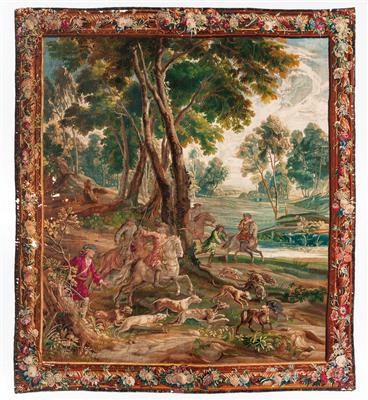A Tapestry,

Brussels, height c. 340 x width 300 cm, early 18th century, silk and wool weaving from a series of hunting scenes. A courtly hunting party is chasing a wolf with numerous hounds. The present item’s high quality workmanship creates an impressive effect. Completely preserved, with a few losses and tears as well as old repairs. Entirely mounted on linen. (VP)
See:
Delmarcel, Flemish tapestry, Belgium 1999, page 351.
Prov.:
Counts Henckel von Donnersmarck.
Count Guido Henckel, Prince von Donnersmarck (1830-1916) was one of the most important and successful men of his time in German economy. As the largest Silesian land and mine owner, he exerted a decisive influence on the development of modern economic life in Silesia.
The first three tapestries from a series of hunting scenes (originally offered in around twenty pieces), the mythological tapestry depicting Alexander the Great and the gobelin fragment all come from Neudeck Castle in Silesia (in modern-day Poland). This castle was built on the model of the Château de Pontchartrain near Paris, which the prince also owned between 1857 and 1888. The palace complex with its vast park was one of the largest and most luxurious in the German Empire and was referred to as “Little Versailles” or “Upper Silesian Versailles”. Its unique ensemble comprises the Old and New Palace, the Cavalier’s Palace and the Donnersmarcks’ burial chapel, which was built at the same time. Emperor William II visited the castle several times and enjoyed hunting in the surrounding woods. The emperor, who also often took out loans from the count, eventually elevated Count Guido to the rank of Prince in recognition of his merits in the political and economic fields. As a result, Neudeck became the family seat of a princely house. It was also the administrative centre of extensive estates stretching over a total area of 27,500 ha in Eastern Central Europe, mainly in Upper Silesia (were numerous mines were located), but also in Austrian Galicia and Russian-occupied Congress Poland.
The tapestries were passed down by descent to the Prince’s heirs.
Expert: Vincent Pillinger
 Vincent Pillinger
Vincent Pillinger
+43-1-515 60-314
vincent.pillinger@dorotheum.at
08.09.2020 - 14:00
- Dosažená cena: **
-
EUR 37.800,-
- Vyvolávací cena:
-
EUR 4.000,-
A Tapestry,
Brussels, height c. 340 x width 300 cm, early 18th century, silk and wool weaving from a series of hunting scenes. A courtly hunting party is chasing a wolf with numerous hounds. The present item’s high quality workmanship creates an impressive effect. Completely preserved, with a few losses and tears as well as old repairs. Entirely mounted on linen. (VP)
See:
Delmarcel, Flemish tapestry, Belgium 1999, page 351.
Prov.:
Counts Henckel von Donnersmarck.
Count Guido Henckel, Prince von Donnersmarck (1830-1916) was one of the most important and successful men of his time in German economy. As the largest Silesian land and mine owner, he exerted a decisive influence on the development of modern economic life in Silesia.
The first three tapestries from a series of hunting scenes (originally offered in around twenty pieces), the mythological tapestry depicting Alexander the Great and the gobelin fragment all come from Neudeck Castle in Silesia (in modern-day Poland). This castle was built on the model of the Château de Pontchartrain near Paris, which the prince also owned between 1857 and 1888. The palace complex with its vast park was one of the largest and most luxurious in the German Empire and was referred to as “Little Versailles” or “Upper Silesian Versailles”. Its unique ensemble comprises the Old and New Palace, the Cavalier’s Palace and the Donnersmarcks’ burial chapel, which was built at the same time. Emperor William II visited the castle several times and enjoyed hunting in the surrounding woods. The emperor, who also often took out loans from the count, eventually elevated Count Guido to the rank of Prince in recognition of his merits in the political and economic fields. As a result, Neudeck became the family seat of a princely house. It was also the administrative centre of extensive estates stretching over a total area of 27,500 ha in Eastern Central Europe, mainly in Upper Silesia (were numerous mines were located), but also in Austrian Galicia and Russian-occupied Congress Poland.
The tapestries were passed down by descent to the Prince’s heirs.
Expert: Vincent Pillinger
 Vincent Pillinger
Vincent Pillinger
+43-1-515 60-314
vincent.pillinger@dorotheum.at
|
Horká linka kupujících
Po-Pá: 9.00 - 18.00
kundendienst@dorotheum.at +43 1 515 60 200 |
| Aukce: | Majetek aristokratického původu a předměty důležitých proveniencí |
| Typ aukce: | Sálová aukce s Live bidding |
| Datum: | 08.09.2020 - 14:00 |
| Místo konání aukce: | Wien | Palais Dorotheum |
| Prohlídka: | 02.09. - 08.09.2020 |
** Kupní cena vč. poplatku kupujícího a DPH
Není již možné podávat příkazy ke koupi přes internet. Aukce se právě připravuje resp. byla již uskutečněna.
